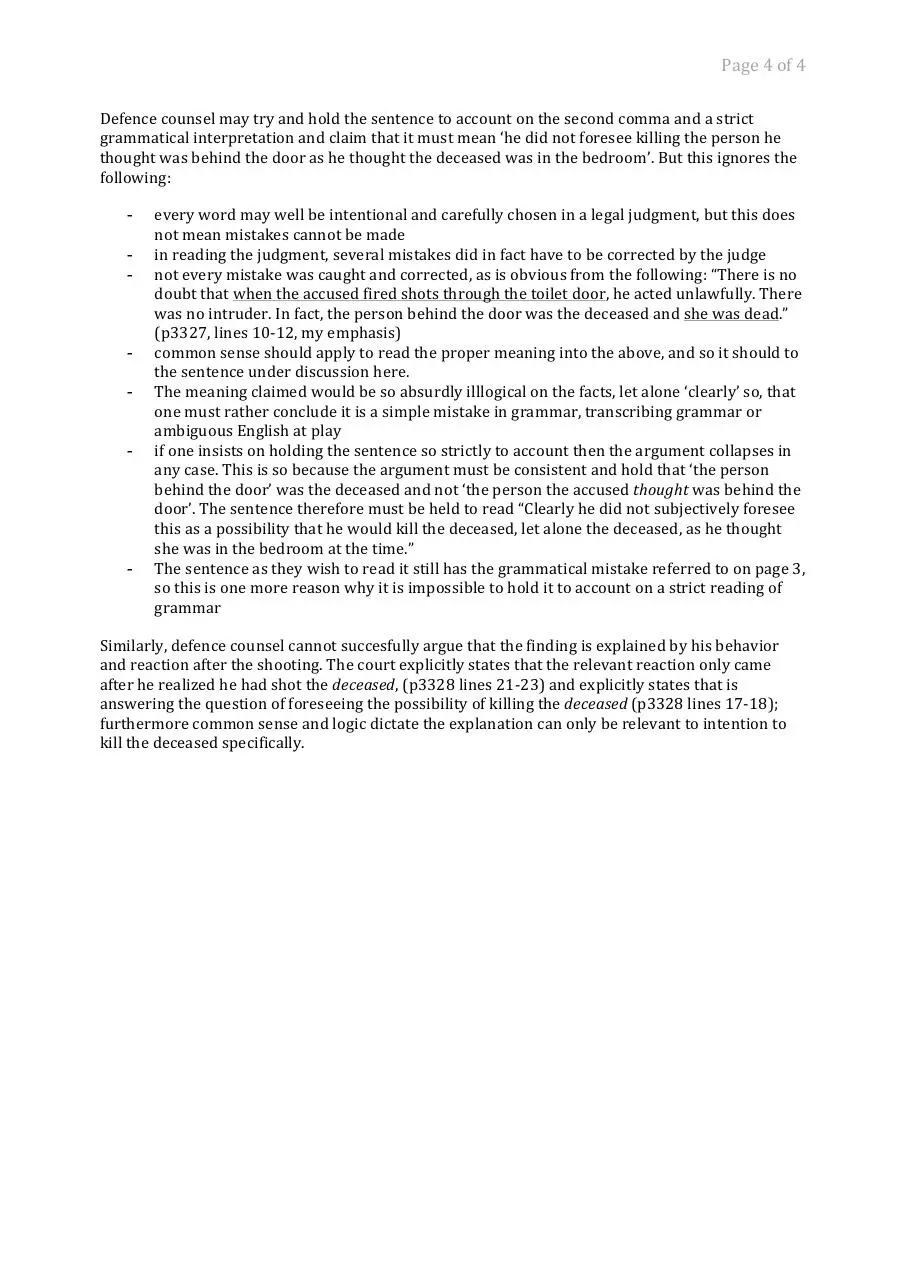Pistorius (PDF)
File information
Title: Pistorius
This PDF 1.3 document has been generated by Word / Mac OS X 10.9.4 Quartz PDFContext, and has been sent on pdf-archive.com on 24/10/2014 at 18:46, from IP address 87.114.x.x.
The current document download page has been viewed 380 times.
File size: 95.58 KB (4 pages).
Privacy: public file




File preview
Page 1 of 4
The court’s findings of fact:
• “The accused was not truthful to the court when asked about his intentions that morning”
(p3321, lines 3-‐4)
• “The accused was clearly not candid with the court when he said that he had no intention
to shoot at anyone” (p3321, lines 5-‐6)
• “He clearly wanted to use the firearm to shoot at the perceived danger” (p3317, lines 17-‐
18)
• “it cannot be said that the accused did not entertain a genuine belief that there was an
intruder in the toilet, who posed a threat to him” (p3347, lines 22-‐25)
• “the blow was meant for the person behind the toilet door, who the accused believed was
an intruder” (p3325, lines 4-‐5)
• “He had intention to shoot at the person in the toilet” (p3325, line 11)
• The measures he took were “to deal with what he considered a threat to his life” (p3321,
line 24)
However:
• “He was competent in the use of firearms as he had undergone some training.” (p3324 line
25 to p3325 line 1)
• “this court is satisfied that at the relevant time, the accused could distinguish between right
and wrong and that he could act in accordance with that distinction” (p3314 line 25 to
p3315 line 2)
• “why the accused fired not one shot but four shots” does not “make sense” (p3320,
line 9 and line 23).
This must entail that the court could not reasonably find on the evidence the possibility that
he believed he was entitled to fire shots 2, 3 and 4
• A reasonable person with the accused’s disabilities in the same circumstances:
-‐ would not have fired 4 shots as this was excessive force.
-‐ would have foreseen this extent of force may unlawfully kill whoever was behind the door
-‐ (p3333 line 13 to p3334 line 16, p3329 line 17-‐20)
Common cause facts or the accused’s own evidence:
The accused: is not of reduced intellect; was not intoxicated; knew the toilet was a small space; was
a gun enthusiast with training; knew the weapon and ammunition he was using was high-‐calibre,
black-‐talon and lethal; had featured in a video where he shot and observed the effect of bullets;
prior to shooting was thinking in detail about the possibilities of a threat and his steps in relation
to it; foresaw the possibility of a ricochet from a warning shot in the bathroom hitting and injuring
himself.
Page 2 of 4
The correct principle of law on murder dolus eventualis and error in objecto
The question is: did the accused foresee and accept the possibility of unlawfully killing whoever
he thought was behind the door?
This is not just an important legal principle, it is an important moral principle also.
The correct principle of law to determine subjective intention:
“One should also avoid the flawed process of deductive reasoning that, because the appellant
should have foreseen the consequences, it can be concluded that he did. That would conflate the
different tests for dolus and negligence. On the other hand, like any other fact, subjective foresight
can be proved by inference. Moreover, common sense dictates that the process of inferential
reasoning may start out from the premise that, in accordance with common human experience, the
possibility of the consequences that ensued would have been obvious to any person of normal
intelligence. The next logical step would then be to ask whether, in the light of all the facts and
circumstances of this case, there is any reason to think that the appellant would not have shared
this foresight, derived from common human experience, with other members of the general
population.” SCA in Humphreys v The State (2013)
““One would normally impute to a person in the position of the appellant (in the absence of any
evidence by such person as to his state of mind at the relevant time) a state of mind akin to that of a
reasonable man. In a given case, however, proved fact or circumstances may exist which would
justify a different conclusion.” SCA in S v De Oliveira (1993)
The court found the accused did not testify credibly on his intentions, and rejected his common
explanation for why he did not have intention to either shoot or kill. Neither he or his defence
counsel ever led evidence or argued that he intended to shoot without foreseeing the possibility
of killing whoever was behind the door. There is therefore no direct testimony or even argument
on which such a finding could be based.
The court if it applied the principles of law correctly to its own findings of fact
should have:
• identified the requisite intention for murder dolus eventualis as foreseeing and
accepting the possibility of unlawfully killing whoever he thought was behind the
door
• determined subjective intention on the starting premise that one has a state of mind
akin to a reasonable man unless there is evidence to reasonably doubt otherwise
• therefore found that the accused had intention to unlawfully fire shots 2, 3 and
4 accepting he may kill whoever he thought was behind the door as a
consequence.
• Guilty of murder dolus eventualis, minimum sentence 15yrs.
Page 3 of 4
A finding of fact that cannot stand in law
If the court made a finding that the accused reasonably and possibly did not foresee and accept the
possibility of killing the person who he mistakenly thought was behind the door, then this fact
cannot stand in law or on the principles of justice. s146 (b) of the Criminal Procedure Act:
“A judge presiding at a criminal trial in a superior court shall-‐ whether he sits with or without
assessors, give the reasons for the decision or finding of the court upon any question of fact”
The court ignored its own direction and for dolus eventualis only concerned itself with the
question of foreseeing the possibility of killing the deceased, As a result it is clear that it only
offered an explanation to answer this question. It did not offer an explanation for whether he
foresaw the possibility of killing the person he mistakenly thought was behind the door, so this -‐
finding of fact therefore cannot stand in law.
It would be nonsensical for defence counsel to try and argue that the finding is explained in p3328
lines 18-‐20 (and therefore must stand on appeal, making a murder conviction impossible, as it is
trite that an objection to the reasoning in a judgment is not a question of law). Such argument
would be little more than an attempt at a trick of strict grammatical interpretation that flies in the
face of any common sense. The sentence in question is:
“Clearly he did not subjectively foresee this as a possibility that he would kill the person behind the
door, let alone the deceased, as he thought she was in the bedroom at the time.” (p3328, lines 18-‐
20)
Without going into a long excursion into grammatical rules, several points need to be borne in
mind:
-
This judgment was read into the record, the commas were not read out, so the presence of
commas and therefore the resultant grammar is determined by the transcriber.
The use of ‘she’ can only reasonably refer to the deceased, and it cannot possibly
reasonably be held that the sentence sought to say ‘he did not foresee killing the person he
thought was behind the door as he thought she was in the bedroom’
This in itself reveals a fundamental grammatical mistake in the structure of the sentence, as
parentheses should be such that when omitted from a sentence the sentence is still
coherent and the meaning holds.
It is therefore possible, if not probable, that the presence of the second comma and the
resultant parenthesis is simply a mistake
Without the second comma, the sentence reads: “Clearly he did not subjectively foresee this
as a possibility that he would kill the person behind the door, let alone the deceased as he
thought she was in the bedroom at the time.”
This makes perfect sense, as the explanation in the second clause of the sentence only
applies to the second clause not the first clause, and the meaning is completely logical on
the facts.
Page 4 of 4
Defence counsel may try and hold the sentence to account on the second comma and a strict
grammatical interpretation and claim that it must mean ‘he did not foresee killing the person he
thought was behind the door as he thought the deceased was in the bedroom’. But this ignores the
following:
-
-
-
every word may well be intentional and carefully chosen in a legal judgment, but this does
not mean mistakes cannot be made
in reading the judgment, several mistakes did in fact have to be corrected by the judge
not every mistake was caught and corrected, as is obvious from the following: “There is no
doubt that when the accused fired shots through the toilet door, he acted unlawfully. There
was no intruder. In fact, the person behind the door was the deceased and she was dead.”
(p3327, lines 10-‐12, my emphasis)
common sense should apply to read the proper meaning into the above, and so it should to
the sentence under discussion here.
The meaning claimed would be so absurdly illlogical on the facts, let alone ‘clearly’ so, that
one must rather conclude it is a simple mistake in grammar, transcribing grammar or
ambiguous English at play
if one insists on holding the sentence so strictly to account then the argument collapses in
any case. This is so because the argument must be consistent and hold that ‘the person
behind the door’ was the deceased and not ‘the person the accused thought was behind the
door’. The sentence therefore must be held to read “Clearly he did not subjectively foresee
this as a possibility that he would kill the deceased, let alone the deceased, as he thought
she was in the bedroom at the time.”
The sentence as they wish to read it still has the grammatical mistake referred to on page 3,
so this is one more reason why it is impossible to hold it to account on a strict reading of
grammar
Similarly, defence counsel cannot succesfully argue that the finding is explained by his behavior
and reaction after the shooting. The court explicitly states that the relevant reaction only came
after he realized he had shot the deceased, (p3328 lines 21-‐23) and explicitly states that is
answering the question of foreseeing the possibility of killing the deceased (p3328 lines 17-‐18);
furthermore common sense and logic dictate the explanation can only be relevant to intention to
kill the deceased specifically.
Download Pistorius
Pistorius.pdf (PDF, 95.58 KB)
Download PDF
Share this file on social networks
Link to this page
Permanent link
Use the permanent link to the download page to share your document on Facebook, Twitter, LinkedIn, or directly with a contact by e-Mail, Messenger, Whatsapp, Line..
Short link
Use the short link to share your document on Twitter or by text message (SMS)
HTML Code
Copy the following HTML code to share your document on a Website or Blog
QR Code to this page

This file has been shared publicly by a user of PDF Archive.
Document ID: 0000190671.